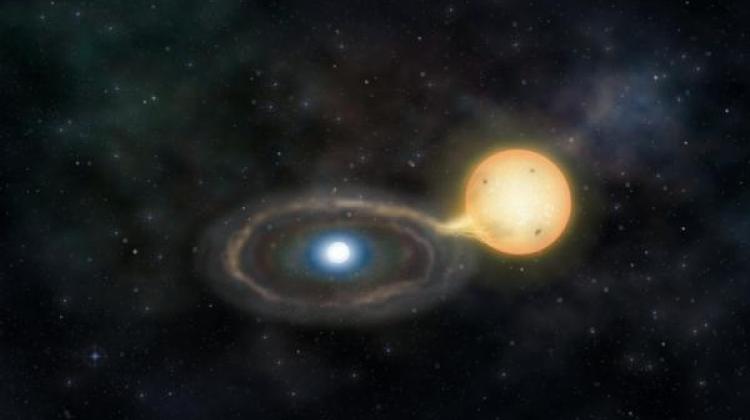Gaia satellite witnessed one star devour another
 Artist impression of the cataclysmic system Gaia14aee, consisting of hot white dwarf devouring another star in the system. Matter falling on the white dwarf forms a disk around it. Source: Institute of Astronomy, University of Cambridge.
Artist impression of the cataclysmic system Gaia14aee, consisting of hot white dwarf devouring another star in the system. Matter falling on the white dwarf forms a disk around it. Source: Institute of Astronomy, University of Cambridge.
An international team of scientists, including astronomers from the University of Warsaw and University of Wroclaw, observed a close binary star system, in which one of the components "devours" the other.
Astronomy enthusiasts significantly contributed to the discovery of the object properties.
The observed binary system belongs to a category astronomers call cataclysmic stars. Such systems consist of a white dwarf and a second star, located very close to each other. The white dwarf steals matter from its companion, and the matter does not fall directly on the white dwarf, but forms an accretion disk around it.
Stealing matter from its neighbour by a white dwarf leads to explosions, and one of them was observed in August 2014, via the satellite Gaia of the European Space Agency (ESA). A special system of alerts was developed to detect such unusual behaviour of stars. It was prepared by researchers from the University of Cambridge (United Kingdom) and the University of Warsaw.
The object was designated Gaia14aae, and information about its discovery was passed to professional astronomers and astronomy enthusiasts. One of the groups that made further observations, is part of the Center of Backyard Astrophysics (CBA). Its ground-based observations confirmed the explosion. In addition, it turned out that orbits of the stars are so positioned relative to the Earth, that these objects obscure each other during the orbital motion. Such an eclipse occurs at about 50 minutes.
Further ground-based observations were also carried out by a network of observatories in the European project OPTICON. In particular, the key data came from two Polish observatories: in Ostrowik near Warsaw and Białków near Wrocław. In addition, the Warsaw students watched the object from the observatory in Loiano near Bologna, Italy.
Observations with the 4.2-meter William Herschel Telescope in the Canary Islands, carried out by the group led by Dr. Heather Campbell of the Institute of Astronomy in Cambridge, showed that there is much helium in the spectrum of the star, but no hydrogen. This means that the system Gaia14aae belongs to a rare class AM Canum Venaticorum (AM CVn). In addition, this is the first case of this class, for which a total eclipse of stars has been observed.
The white dwarf in a Gaia14aae has a mass of about one solar mass and dimensions similar to the dimensions of the Earth. In turn, the second star has a very low mass, only 1.5 percent solar mass, but it is very "bloated". The system is located about 730 light years from us.
Gaia observatory was launched by ESA in December 2013. In June 2014, the satellite started a five-year project of observing the whole sky. It will study the movements and brightness of a billion stars in the Milky Way. Each of the stars will be observed around 100 times, which makes it possible to search for variable and irregular objects, for example explosions.
"This discovery, made in the first months of Gaia satellite operation, shows the true potential of this mission and the sky anomaly detection system, which we coordinate" - summed up Dr. Łukasz Wyrzykowski from the Astronomical Observatory of the University of Warsaw.
The scientist is responsible for organizing the network of terrestrial telescopes that carry out complementary observations of phenomena detected by Gaia satellite. The project of such observations is part of the European OPTICON program, which is financed under the 7th EU Framework Programme. Additional funding for Polish scientists comes from grants from the Ministry of Science and Higher Education and the National Science Centre.
PAP - Science and Scholarship in Poland
cza/ agt/
tr. RL
Przed dodaniem komentarza prosimy o zapoznanie z Regulaminem forum serwisu Nauka w Polsce.















